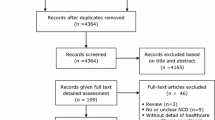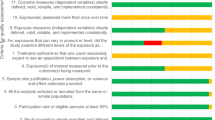Abstract
Background and Objectives
India has one of the world’s highest proportions of out-of-pocket expenditure (OOPE) payments. The low share of public health expenditure coupled with the double burden of disease (communicable and non-communicable) has a direct financial impact on individual OOPE and an indirect impact in the form of decreasing life expectancy, reduced productivity, and hence a negative impact on economic growth. This systematic review aims to compare and assess the estimated economic cost of non-communicable diseases (NCDs) in India and ascertain the methods used to derive these estimates.
Methods
This paper reviews the past 12-year (2010–22) literature on the economic impact of health shocks due to NCDs. Three databases were searched for the literature: PubMed, Scopus, and Google Scholar. Thematic analysis has been performed to analyse the findings of the study.
Results
The OOPE was very high for NCDs. The increasing cost was high and unaffordable, pushing many people into financial distress measured by catastrophic payments and rising impoverishment.
Conclusion
The results indicate both the direct and indirect impact of NCDs, but the indirect burden of loss of employment and productivity, despite its relevance, has been less studied in the literature. A robust economic analysis will allow an evidence-based policy decision perspective to reduce the rising burden of NCDs.

Similar content being viewed by others
References
‘WHO factsheet on non-communicable diseases (April 2021)’. https://www.who.int/news-room/fact-sheets/detail/noncommunicable-diseases. Accessed 2 May 2022.
Budreviciute A, et al. Management and prevention strategies for non-communicable diseases (NCDs) and their risk factors. Front Public Health. 2020;8:788.
Yadav J, Allarakha S, Menon GR, John D, Nair S. Socioeconomic impact of hospitalisation expenditure for treatment of noncommunicable diseases in India: a repeated cross-sectional analysis of national sample survey data, 2004 to 2018. Value Health Reg Issues. 2021;24:199–213.
Nethan S, Sinha D, Mehrotra R. Non communicable disease risk factors and their trends in India. Asian Pac J Cancer Prev. 2017;18(7):2005.
Prabhakaran D, et al. The changing patterns of cardiovascular diseases and their risk factors in the states of India: the Global Burden of Disease Study 1990–2016. Lancet Glob Health. 2018;6(12):e1339–51.
Asma S, et al. Monitoring the health-related sustainable development goals: lessons learned and recommendations for improved measurement. Lancet. 2020;395(10219):240–6.
Dandona L, et al. Nations within a nation: variations in epidemiological transition across the states of India, 1990–2016 in the Global Burden of Disease Study. Lancet. 2017;390(10111):2437–60.
Taylor DW. The burden of non-communicable diseases in India. Glasgow: Cameron Institute; 2010.
Pandey SK, Sharma V. World diabetes day 2018: battling the emerging epidemic of diabetic retinopathy. Indian J Ophthalmol. 2018;66(11):1652.
Abegunde DO, Mathers CD, Mathers C. Chronic diseases 1 the burden and costs of chronic diseases in low-income and middle-income countries. www.thelancet.com. 370:929–1967. https://doi.org/10.1016/S0140.
Murray CJL, Lopez AD. Alternative projections of mortality and disability by cause 1990–2020: global burden of disease study. The Lancet. 1997;349(9064):1498–504.
Government of India Ministry of Health and Family Welfare. Report of National Health Account Estimates for India for 2017–18.
Gupta I, Ranjan A. Public expenditure on non-communicable diseases and injuries in India: a budget-based analysis. PLoS ONE. 2019. https://doi.org/10.1371/journal.pone.0222086.
Domestic general government health expenditure (GGHE-D) as percentage of gross domestic product (GDP) (%). https://www.who.int/data/gho/data/indicators/indicator-details/GHO/domestic-general-government-health-expenditure-(gghe-d)-as-percentage-of-gross-domestic-product-(gdp)-(-). Accessed 4 Feb 2023.
McKeown RE. The epidemiologic transition: changing patterns of mortality and population dynamics. Am J Lifestyle Med. 2009;3(1_suppl):19S-26S.
de Mello LF, de Paula SA. Challenges of demographic and epidemiological transitions. In: No Poverty. 2020. p. 69–79. https://doi.org/10.1007/978-3-319-95714-2.
Bloom DE et al. Economics of non-communicable diseases in India: the costs and returns on investment of interventions to promote healthy living and prevent, treat, and manage NCDs. In: World economic forum. Harvard School of Public Health; 2014. p. 22–3.
Bloom DE, et al. The macroeconomic impact of non-communicable diseases in China and India: estimates, projections, and comparisons. J Econ Ageing. 2014;4:100–11.
Keane M, Thakur R. Health care spending and hidden poverty in India. Res Econ. 2018;72(4):435–51. https://doi.org/10.1016/j.rie.2018.08.002.
Balarajan Y, Selvaraj S, Subramanian SV. Health care and equity in India. Lancet. 2011;377(9764):505–15.
Yadav J, John D, Menon G. Out of pocket expenditure on tuberculosis in India: do households face hardship financing? Indian J Tuberc. 2019;66(4):448–60. https://doi.org/10.1016/j.ijtb.2019.02.016.
Behera S, Pradhan J. Uneven economic burden of non-communicable diseases among Indian households: a comparative analysis. PLoS ONE. 2021;16(12): e0260628.
Menon GR, Yadav J, John D. Burden of non-communicable diseases and its associated economic costs in India. Soc Sci Humanities Open. 2022;5(1): 100256.
Verma VR, Kumar P, Dash U. Assessing the household economic burden of non-communicable diseases in India: evidence from repeated cross-sectional surveys. BMC Public Health. 2021;21(1):1–22.
Wagstaff A, O’Donnell O, van Doorslaer E, Lindelow M. Analyzing health equity using household survey data: a guide to techniques and their implementation. Washington: World Bank Publications; 2007.
Joshi A, Mohan K, Grin G, Perin DMP. Burden of health care utilization and out-of-pocket costs among individuals with NCDs in an Indian setting. J Community Health. 2013;38(2):320–7. https://doi.org/10.1007/s10900-012-9617-1.
Joseph N, Gupta S. Assessment of economic impact among in-patients with non-communicable diseases in a private tertiary care hospital in Southern India. J Clin Diagn Res. 2016;10(6):LM04–6. https://doi.org/10.7860/JCDR/2016/19426.8059.
Binnendijk E, Koren R, Dror DM. Can the rural poor in India afford to treat non-communicable diseases. Trop Med Int Health. 2012;17(11):1376–85.
Yadav J, Menon GR, John D. Disease-specific out-of-pocket payments, catastrophic health expenditure and impoverishment effects in India: an analysis of National Health Survey data. Appl Health Econ Health Policy. 2021;19(5):769–82. https://doi.org/10.1007/s40258-021-00641-9.
Singh P, Kumar V. The rising burden of health care expenditure in India: a poverty nexus. Soc Indic Res. 2017;133(2):741–62.
Kastor A, Mohanty SK. Disease and age pattern of hospitalisation and associated costs in India: 1995–2014. BMJ Open. 2018;8(1): e016990.
Kastor A, Mohanty SK. Disease-specific out-of-pocket and catastrophic health expenditure on hospitalization in India: do Indian households face distress health financing? PLoS ONE. 2018;13(5):e0196106.
Tripathy JP, et al. Cost of hospitalisation for non-communicable diseases in India: are we pro-poor? Trop Med Int Health. 2016;21(8):1019–28.
Barik D, Arokiasamy P. Rising health expenditure due to non-communicable diseases in India: an outlook. Front Public Health. 2016;4:268.
Pati S, et al. Non communicable disease multimorbidity and associated health care utilization and expenditures in India: cross-sectional study. BMC Health Serv Res. 2014;14(1):1–9.
Mahal A, Karan A, Engelgau M. The economic implications of non-communicable disease for India. Health, Nutrition and Population (HNP) discussion paper; © World Bank, Washington, DC. 2010;8. https://openknowledge.worldbank.org/handle/10986/13649.
Yadav P, Kulkarni VS, Gaiha R. Growing burden of non-communicable diseases in India. University of Pennsylvania Population Center Working Paper (PSC/PARC), 2018;20. https://repository.upenn.edu/psc_publications/20.
Kumar, et al. Socio-economic differentials in impoverishment effects of out-of-pocket health expenditure in China and India: evidence from WHO SAGE. PLoS ONE. 2015;10(8): e0135051.
Engelgau M, Karan A, Mahal A. The economic impact of non-communicable diseases on households in India. Glob Health. 2012;8(1):1–10.
Kulkarni VS, Kulkarni VS, Gaiha R. Employment, aging and disease in India. University of Pennsylvania Population Center Working Paper (PSC/PARC), 2019;29. https://repository.upenn.edu/psc_publications/29.
Agarwal A, Lubet A, Chen S, Khoury AKA, Bloom DE. Non-communicable diseases and their macroeconomic impact in India. Econ Polit Wkly. 2021;56(51):56–63.
Menon GR, et al. National burden estimates of healthy life lost in India, 2017: an analysis using direct mortality data and indirect disability data. Lancet Glob Health. 2019;7(12):e1675–84.
Taylor PN, et al. Global epidemiology of hyperthyroidism and hypothyroidism. Nat Rev Endocrinol. 2018;14(5):301–16.
Mahal A, Karan A, Fan VY, Engelgau M. The economic burden of cancers on Indian households. PLoS ONE. 2013;8(8): e71853.
Karan A, Engelgau M, Mahal A. The household-level economic burden of heart disease in India. Trop Med Int Health. 2014;19(5):581–91.
Jaspers L, et al. The global impact of non-communicable diseases on households and impoverishment: a systematic review. Eur J Epidemiol. 2014;30(3):163–88. https://doi.org/10.1007/s10654-014-9983-3.
Muka T, et al. The global impact of non-communicable diseases on health care spending and national income: a systematic review. Eur J Epidemiol. 2015;30(4):251–77. https://doi.org/10.1007/s10654-014-9984-2.
Rajpal S, Kumar A, Joe W. Economic burden of cancer in India: evidence from cross-sectional nationally representative household survey, 2014. PLoS ONE. 2018;13(2): e0193320.
Gwatidzo SD, Stewart Williams J. ‘Diabetes mellitus medication use and catastrophic health care expenditure among adults aged 50 + years in China and India: results from the WHO study on global AGEing and adult health (SAGE). BMC Geriatr. 2017;17(1):1–15.
Nagarathna R, et al. Cost of management of diabetes mellitus: a pan India study. Ann Neurosci. 2020;27(3–4):190–2.
Patel S, Ram F, Patel SK, Kumar K. Cardiovascular diseases and health care expenditure (HCE) of inpatient and outpatient: a study from India Human Development Survey. Clin Epidemiol Glob Health. 2020;8(3):671–7.
Dhankhar A, Kumari R, Bahurupi YA. Out-of-pocket, catastrophic health expenditure and distress financing on non-communicable diseases in India: a systematic review with meta-analysis. Asian Pac J Cancer Prev. 2021;22(3):671–80. https://doi.org/10.31557/APJCP.2021.22.3.671.
Gupta I, Roy A. Economic studies on non-communicable diseases and injuries in India: a systematic review. Appl Health Econ Health Policy. 2018;16(3):303–15. https://doi.org/10.1007/s40258-018-0370-1.
Reich MR. World bank, world development report 1993: investing in health. Econ Dev Cult Change. 1997;45:899–903.
Vos T, et al. Global burden of 369 diseases and injuries in 204 countries and territories, 1990–2019: a systematic analysis for the Global Burden of Disease Study 2019. Lancet. 2020;396(10258):1204–22.
Author information
Authors and Affiliations
Corresponding author
Ethics declarations
Conflict of interest
The authors have no conflicts of interest to declare.
Funding source
No funding was received for this research.
Ethics approval
Not applicable.
Consent to participate
Not applicable.
Consent for publication (from patients/participants)
Not applicable.
Availability of data and material
The data used in analyses were generated by examining full-text papers from PubMed and Scopus. The paper was located using Google Scholar and ScienceDirect in case of the unavailability of full-length articles from the above database.
Code availability
Not applicable.
Authors’ contributions
Both authors have identified the research questions and selected studies based on inclusion and exclusion criteria. Ms VS has defined the inclusion and exclusion criteria, extracted the data from the studies, analyzed the data, and wrote the manuscript. Dr RA has provided critical comments and suggestions to arrive at the final manuscript.
Electronic supplementary material
Below is the link to the electronic supplementary material.
Rights and permissions
Springer Nature or its licensor (e.g. a society or other partner) holds exclusive rights to this article under a publishing agreement with the author(s) or other rightsholder(s); author self-archiving of the accepted manuscript version of this article is solely governed by the terms of such publishing agreement and applicable law.
About this article
Cite this article
Shukla, V., Arora, R. The Economic Cost of Rising Non-communicable Diseases in India: A Systematic Literature Review of Methods and Estimates. Appl Health Econ Health Policy 21, 719–730 (2023). https://doi.org/10.1007/s40258-023-00822-8
Accepted:
Published:
Issue Date:
DOI: https://doi.org/10.1007/s40258-023-00822-8




